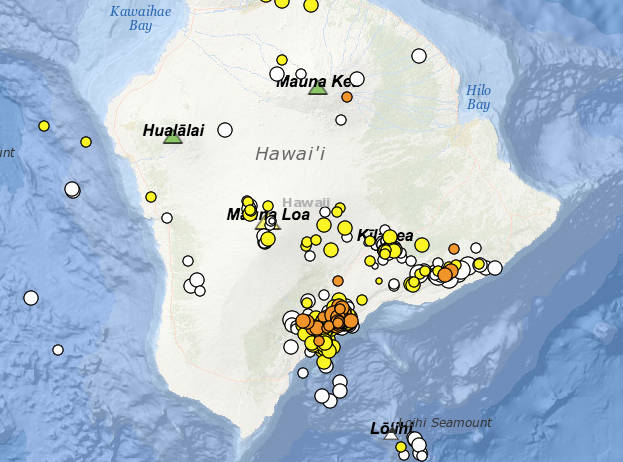Nearly 6,000 earthquakes have been recorded in the past eight months beneath Kilauea’s lower Southeast Rift Zone near Pahala in Ka‘u.
Nearly 6,000 earthquakes have been recorded in the past eight months beneath Kilauea’s lower Southeast Rift Zone near Pahala in Ka‘u.
The U.S. Geological Survey said Wednesday the Hawaiian Volcano Observatory has recorded over 5,900 earthquakes in a cluster about 6 miles wide near Pahala. These temblors are occurring at a depth of 15 miles to 25 miles.
Most of the earthquakes have been magnitude-2.0 or lower, and haven’t been felt by residents, according to the observatory. The strongest earthquake, a magnitude-3.5, was recorded on Jan. 6.
“Clustering of deep earthquakes in this region does not mean an eruption is imminent. HVO has recorded earthquakes in this area for many decades across several eruptive cycles at both Kilauea and Mauna Loa volcanoes. No correlation between seismic activity in this zone and volcanic activity at the surface has been established, although this is an important topic for future research,” the observatory’s scientists said.
HVO said past studies suggest the earthquakes are the result of stresses caused by transport of magma through the Earth’s mantle deep beneath the island, an area that may be the source region supplying magma to the active volcanoes.
Since August 2019, there’s been between 20 to 40 earthquakes per day with a peak of 80 per day in February.
“These rates are the highest ever measured for the area in the 60 years of instrumental observation. A sustained increase of this deep seismicity above long term background levels began as early as November 2015, although at rates lower than currently observed,” the observatory’s scientists said.
The observatory said it continues to monitor all of Hawaii’s volcanoes, including daily analysis of ongoing Pahala area seismicity.
“We will provide additional updates on any significant change in volcano status,” the observatory’s scientists said.

Subscribe today for unlimited access.
Already a subscriber?
Login
Not ready to subscribe?
Register for limited access.
If you have a print subscription but require digital access,
activate your account.






